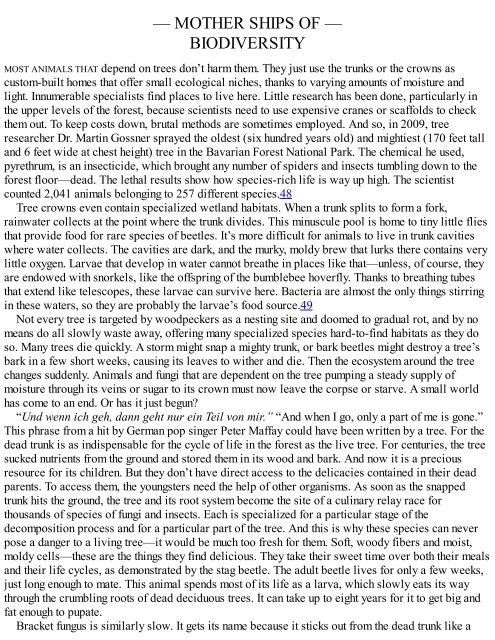You also want an ePaper? Increase the reach of your titles
YUMPU automatically turns print PDFs into web optimized ePapers that Google loves.
— MOTHER SHIPS OF —<br />
BIODIVERSITY<br />
MOST ANIMALS THAT depend on trees don’t harm them. <strong>The</strong>y just use the trunks or the crowns as<br />
custom-built homes that <strong>of</strong>fer small ecological niches, thanks to varying amounts <strong>of</strong> moisture and<br />
light. Innumerable specialists find places to live here. Little research has been done, particularly in<br />
the upper levels <strong>of</strong> the forest, because scientists need to use expensive cranes or scaffolds to check<br />
them out. To keep costs down, brutal methods are sometimes employed. And so, in 2009, tree<br />
researcher Dr. Martin Gossner sprayed the oldest (six hundred years old) and mightiest (170 feet tall<br />
and 6 feet wide at chest height) tree in the Bavarian Forest National Park. <strong>The</strong> chemical he used,<br />
pyrethrum, is an insecticide, which brought any number <strong>of</strong> spiders and insects tumbling down to the<br />
forest floor—dead. <strong>The</strong> lethal results show how species-rich life is way up high. <strong>The</strong> scientist<br />
counted 2,041 animals belonging to 257 different species.48<br />
Tree crowns even contain specialized wetland habitats. When a trunk splits to form a fork,<br />
rainwater collects at the point where the trunk divides. This minuscule pool is home to tiny little flies<br />
that provide food for rare species <strong>of</strong> beetles. It’s more difficult for animals to live in trunk cavities<br />
where water collects. <strong>The</strong> cavities are dark, and the murky, moldy brew that lurks there contains very<br />
little oxygen. Larvae that develop in water cannot breathe in places like that—unless, <strong>of</strong> course, they<br />
are endowed with snorkels, like the <strong>of</strong>fspring <strong>of</strong> the bumblebee hoverfly. Thanks to breathing tubes<br />
that extend like telescopes, these larvae can survive here. Bacteria are almost the only things stirring<br />
in these waters, so they are probably the larvae’s food source.49<br />
Not every tree is targeted by woodpeckers as a nesting site and doomed to gradual rot, and by no<br />
means do all slowly waste away, <strong>of</strong>fering many specialized species hard-to-find habitats as they do<br />
so. Many trees die quickly. A storm might snap a mighty trunk, or bark beetles might destroy a tree’s<br />
bark in a few short weeks, causing its leaves to wither and die. <strong>The</strong>n the ecosystem around the tree<br />
changes suddenly. Animals and fungi that are dependent on the tree pumping a steady supply <strong>of</strong><br />
moisture through its veins or sugar to its crown must now leave the corpse or starve. A small world<br />
has come to an end. Or has it just begun?<br />
“Und wenn ich geh, dann geht nur ein Teil von mir.” “And when I go, only a part <strong>of</strong> me is gone.”<br />
This phrase from a hit by German pop singer Peter Maffay could have been written by a tree. For the<br />
dead trunk is as indispensable for the cycle <strong>of</strong> life in the forest as the live tree. For centuries, the tree<br />
sucked nutrients from the ground and stored them in its wood and bark. And now it is a precious<br />
resource for its children. But they don’t have direct access to the delicacies contained in their dead<br />
parents. To access them, the youngsters need the help <strong>of</strong> other organisms. As soon as the snapped<br />
trunk hits the ground, the tree and its root system become the site <strong>of</strong> a culinary relay race for<br />
thousands <strong>of</strong> species <strong>of</strong> fungi and insects. Each is specialized for a particular stage <strong>of</strong> the<br />
decomposition process and for a particular part <strong>of</strong> the tree. And this is why these species can never<br />
pose a danger to a living tree—it would be much too fresh for them. S<strong>of</strong>t, woody fibers and moist,<br />
moldy cells—these are the things they find delicious. <strong>The</strong>y take their sweet time over both their meals<br />
and their life cycles, as demonstrated by the stag beetle. <strong>The</strong> adult beetle lives for only a few weeks,<br />
just long enough to mate. This animal spends most <strong>of</strong> its life as a larva, which slowly eats its way<br />
through the crumbling roots <strong>of</strong> dead deciduous trees. It can take up to eight years for it to get big and<br />
fat enough to pupate.<br />
Bracket fungus is similarly slow. It gets its name because it sticks out from the dead trunk like a
















